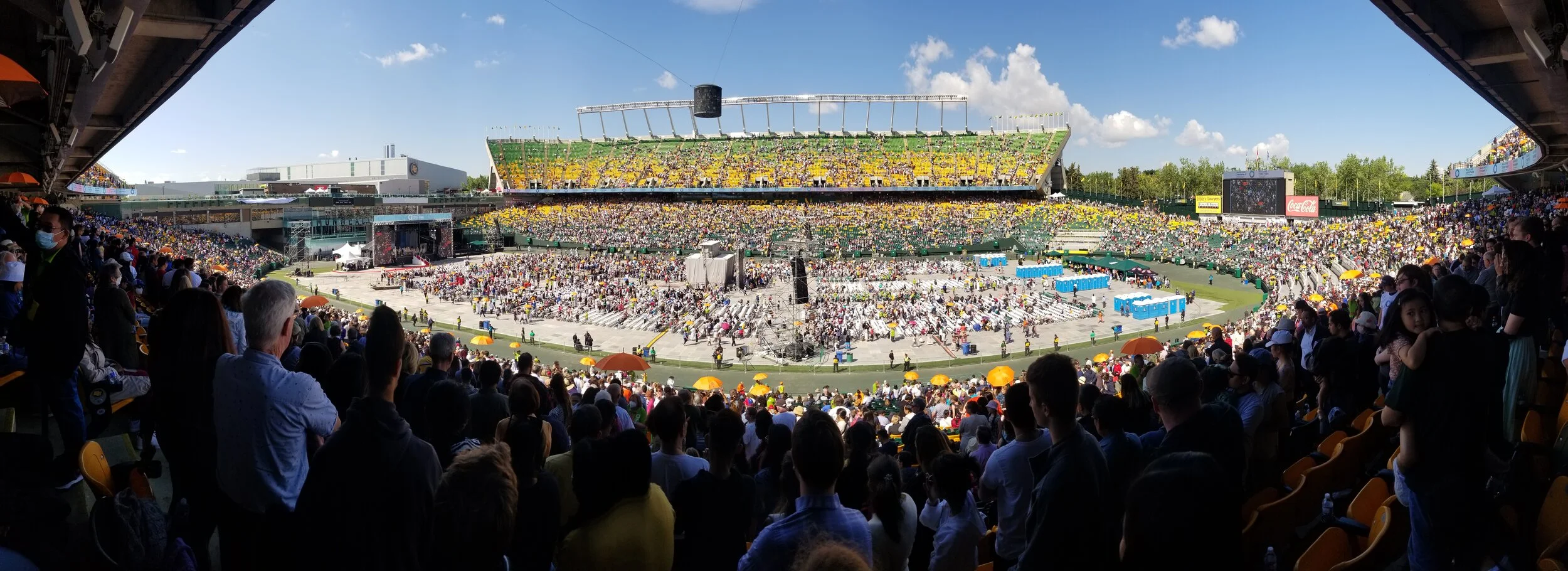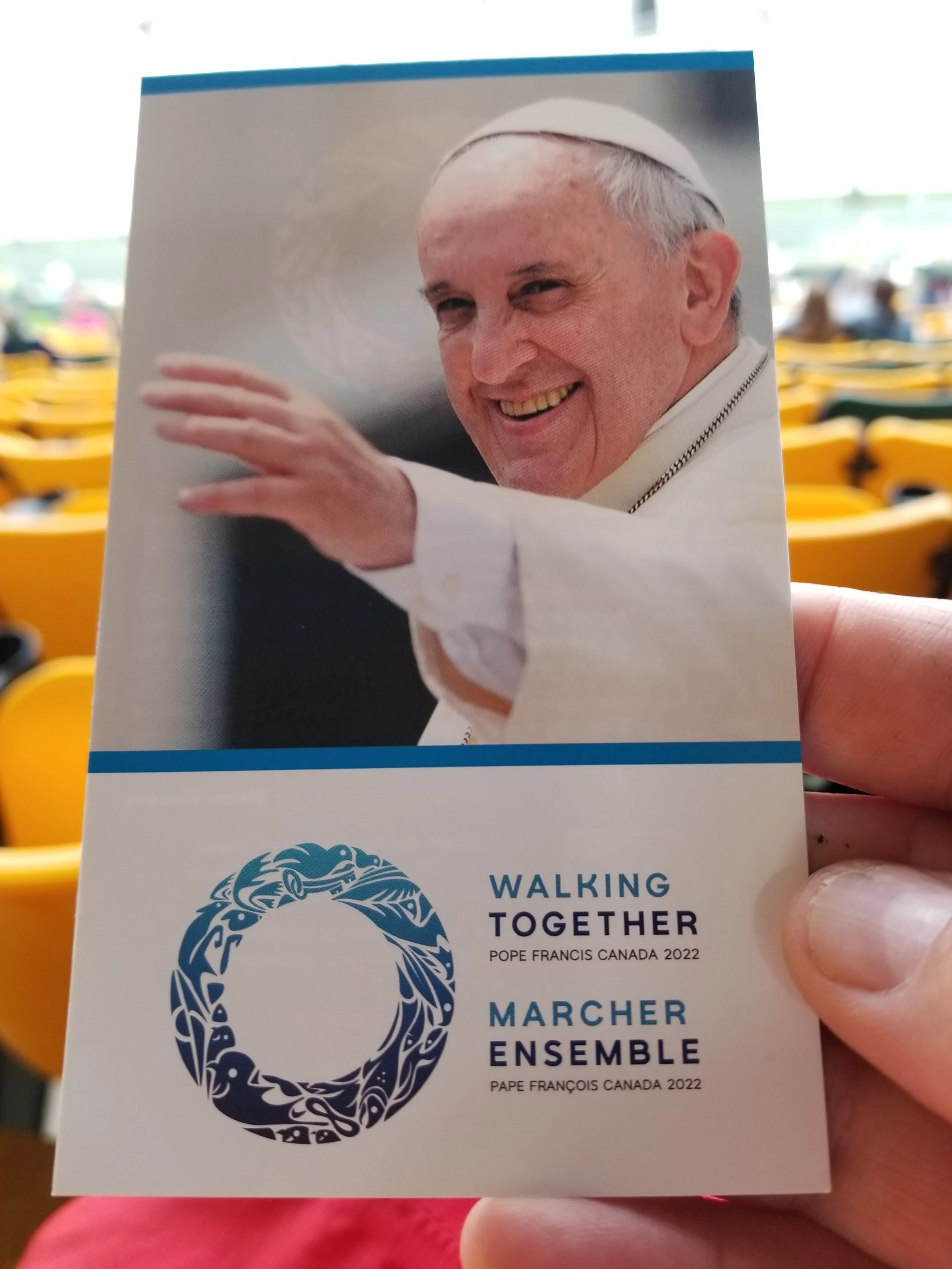“On the Use of the Roman Liturgy”
Pope Francis visited Canada this summer to reconcile the Church with First Nations.
(Chief Phil Lafontaine)
On his first full day, the Holy Father visited Ermineskin Cree Nation, Maskwacis.
(For more information on his visit to Maskwacis: https://www.catholicarena.com/latest/2022/7/26/the-church-reconciling-with-the-first-nations-of-canada)
The following day, he presided over a Papal Mass at the Commonwealth Stadium in Edmonton.
The extensive program included Indigenous music; Chief Phil Fontaine discussed forgiveness after the Residential School tragedy and First Nation readers proclaimed The Word during Mass.
(Papal Mass, Commonwealth Stadium, Edmonton. July 2022)
Sadly, the Holy Father was not able to stand for long, so Archbishop Smith celebrated the Liturgy of the Eucharist. A curious thing: he said the Eucharistic Prayer in Latin!
The Latin added a wonderful sense of tradition and ‘circumstance’ to the Mass, even though most of us didn’t understand a word. I was puzzled by it being in Latin after the 2021 Apostolic Letter, Traditionis Custodes, which severely restricts the use of the ‘Latin Mass.’
I found out afterwards that the Archbishop had used the Latin version of the third Eucharistic Prayer from the regular Mass — the Novus Ordo — and this has been the tradition for Papal Masses abroad for many years. Also, the Latin version of the Novus Ordo is used for most Papal Masses in Rome. Curiouser and curiouser!
Popes, Ecumenical Councils & Latin
Before fixating on Latin being the “traditional language of the Church,” it might be worth remembering that Jesus probably spoke Galilean Aramaic.
Paul III (1534-49): The Council of Trent.
<<< 4 other Popes >>>
St. Pius V (1566-72): Quo Primum requiring the Traditional Rite, 1570
<<< 29 other Popes >>>
Blessed Pius IX (1846-78): First Vatican Council.
<<< 5 other Popes >>>
Blessed John XXIII (1958-63) initiated Second Vatican Council.
Paul VI (1963-78) completed Second Vatican Council.
John Paul I (1978)
John Paul II (1978-2005)
Benedict XVI (2005-2013)
Francis (2013—)
Traditional Latin Mass [TLM]
(Martin Luther)
The Council of Trent arose in response to Martin Luther and the development of Protestantism.
Before 1570, many versions of the Mass were in common usage. St Pius V issued the Papal bull Quo Primum and confirmed the Tridentine Mass as the official Liturgy of the Mass.
The Tridentine Mass (a.k.a. the ‘Traditional Rite’ or the ‘Traditional Latin Mass’ TLM) became the official Liturgy of the Mass, 1570 to 1962. The TLM is written in a formal “Ecclesiastical Latin” and the 1962 Missal is the last version and the one used most frequently. The TLM has other distinct features:
o The Mass is spoken, or in Gregorian chant. (High Mass, chanted / Low Mass, spoken.)
o The sermon is in the local language.
o The priest is ad orientem: facing east and towards the altar.
o The congregation is dressed modestly: women generally wear a head covering, often a mantilla.
o There are more formalized actions (proper genuflection when entering & leaving the pew / double kneel with exposition / more frequent signs of the cross.)
o The congregation prays in silence.
o The Our Father / Pater Noster, is said by the priest alone.
o There is an altar rail or "communion rail."
o The Eucharist is received on the tongue while kneeling at the altar rail, hands under the white cloth.
o The priest utters a prayer in Latin for the communicant, "May the Body of our Lord Jesus Christ preserve your soul unto everlasting life. Amen."
o People do not say 'Amen' before receiving Communion.
o Communion is offered under One Kind only: the Host.
o The congregation may sing antiphonally on some verses.
o There is a Last Gospel after the final blessing: "Ite, Missa est" ("The Mass is ended")
o In a low Mass, there are prayers after the end of Mass.
In his letter, Summorum Pontificum, Pope Benedict XVI supported both forms of the Roman Rite suggesting that they would “enrich one another.”
First Vatican Council
Pope Pius IX convoked the first Vatican Council to deal with the problems of rationalism, liberalism, and materialism. The Council was cut short and only promulgated 2 doctrinal constitutions. Pastor Aeternus, confirmed the Pope as having supreme jurisdiction over the whole Church.
Second Vatican Council
“The Good Pope,” Blessed John XXIII, initiated the second Vatican Council. He died later that year so it fell to Pope Paul VI, who also coordinated the development of the Novus Ordo Mass.
Novus Ordo Missae (NOM)
1969 marked the “new Mass” or the Novus Ordo Missae, which is usually said in the vernacular language of the local people to help the comprehension and involvement of the congregation. It is also available in “Vulgar Latin”: the colloquial Latin in the late Roman Empire. (Vulgar, meaning ‘of the people.’)
The NOM includes a more communal penitential prayer; expanded readings in a 3-year cycle; new Prefaces; a changed Offertory; three new Eucharistic Prayers; modified words of consecration; the Our Father to be said by the whole congregation; a reduction of genuflections, signs of the cross, and bows.
So, what’s with the TLM?
NOTHING! The TLM is a valid Mass of the Roman Catholic Church.
The problem, appears to be with some very traditional Catholics who attend the Traditional Latin Mass because they believe that the Novus Ordo Mass is invalid. Sadly, they go even further. They rationalize that if the NOM is invalid, then the Magisterium and any Pope who has supported the NOM has “promoted heresy”, ergo, “all the Popes since Vatican II are invalid.”
No joke. The term for this schismatic belief is “Sedevacantism.”
To emphasize: many who attend the TLM attend the Novus Ordo also and accept the Pope as the head of the Church on earth, so are not Sedevacantists! These are extremely faithful Catholics who simply love the Traditional Rite because it provides a sense of peace, dignity, predictability and continuity with centuries of Catholic worship.
An Elephant Gun to kill a Fly?
Pope Francis’ Apostolic Letter ‘Traditionis Custodes; On the Use of the Latin Liturgy’ restricts the use of the TLM. We must trust the Holy Father that these restrictions are required and we must respect & comply with his decision, knowing that he is leading us forward!
Traditionis Custodes has eight ‘articles’ which are appended below in Appendix I. Full text is at: https://www.vatican.va/content/francesco/en/motu_proprio/documents/20210716-motu-proprio-traditionis-custodes.html)
Importantly, the Apostolic Letter does not limit the use of the Latin Novus Ordo Missae.
Throwing the baby out with the bathwater
These restrictions might cause the Church to lose some good & faithful Catholics. (This appears to be one reason why the Holy father did not ban the TLM completely.) Still, there is a risk of ‘throwing the baby out with the bathwater.’
The title photo is a woodcut taken from the 1512 book with the earliest version of this German proverb: “Das Kind mit dem Bade ausschütten.” I mention this with some hesitation because of a disconcerting coincidence. In 1512, Martin Luther received his doctorate and became a professor of biblical studies: that worked out so well for the Church.
The people in my vicinity at the Papal Mass were remarkably diverse. There was an elderly native lady with her daughter; large families of Asian and East Indian heritage, but also there was a very conservatively-dressed young couple. The woman put a mantilla on her head during this outdoor Mass. I suspect these good Catholics attend the TLM and they should feel welcome at a Novus Ordo mass too.
(Theme of Papal Visit Canada 2022: Walking Together.)
Walking Together
The theme of the Papal Visit was “Walking Together.” This refers to the Spirit of Reconciliation and walking with our wounded native brothers and sisters.
We ‘Walk Together’ with other communities too: the poor, the incarcerated, the pregnant.
Some Diocese walk together with their parishioners by providing mass in a specific vernacular for their unique population or an energetic Gospel Mass, or a rocking Youth Mass.
It is time to Walk Together with more traditional Catholics too.
A partial solution to the Traditional Latin Mass may be to encourage some parishes to provide the Latin version of the Novus Ordo Missae. They could incorporate many of the features of the TLM — modest dress, proper genuflection, Communion of One Kind, Communion on the tongue and maybe even some Gregorian chant. The Roman Missal even allows for the priest to be ad orientem! (Cardinal Sarah, as the Prefect of the Vatican’s Congregation for Divine Worship, recommended ‘Ad Orientem’ in 2016!)
We all pray in different ways.
Allowing for as much diversity as possible is very good for the Church.
Kevin Hay
(Editor: many younger people feel drawn to the reverence of the Latin Mass while an older generation is anxious that their work since the Council will have been for nothing if the Traditional Mass is revived. At the heart of this is the fact that Pope Benedict XVI wrote in Summorum Pontificum, ‘What previous generations held as sacred, remains sacred and great for us too, and it cannot all of a sudden be forbidden or even considered harmful’.)
APPENDIX I:
The eight articles of, “TRADITIONIS CUSTODES: On the Use of the Roman Liturgy”
Art. 1. The liturgical books promulgated by Saint Paul VI and Saint John Paul II, in conformity with the decrees of Vatican Council II, are the unique expression of the lex orandi of the Roman Rite.
Art. 2. It belongs to the diocesan bishop, as moderator, promoter, and guardian of the whole liturgical life of the particular Church entrusted to him, to regulate the liturgical celebrations of his diocese. Therefore, it is his exclusive competence to authorize the use of the 1962 Roman Missal in his diocese, according to the guidelines of the Apostolic See.
Art. 3. The bishop of the diocese in which until now there exist one or more groups that celebrate according to the Missal antecedent to the reform of 1970:
§ 1. is to determine that these groups do not deny the validity and the legitimacy of the liturgical reform, dictated by Vatican Council II and the Magisterium of the Supreme Pontiffs;
§ 2. is to designate one or more locations where the faithful adherents of these groups may gather for the eucharistic celebration (not however in the parochial churches and without the erection of new personal parishes);
§ 3. to establish at the designated locations the days on which eucharistic celebrations are permitted using the Roman Missal promulgated by Saint John XXIII in 1962. [7] In these celebrations the readings are proclaimed in the vernacular language, using translations of the Sacred Scripture approved for liturgical use by the respective Episcopal Conferences;
§ 4. to appoint a priest who, as delegate of the bishop, is entrusted with these celebrations and with the pastoral care of these groups of the faithful. This priest should be suited for this responsibility, skilled in the use of the Missale Romanum antecedent to the reform of 1970, possess a knowledge of the Latin language sufficient for a thorough comprehension of the rubrics and liturgical texts, and be animated by a lively pastoral charity and by a sense of ecclesial communion. This priest should have at heart not only the correct celebration of the liturgy, but also the pastoral and spiritual care of the faithful;
§ 5. to proceed suitably to verify that the parishes canonically erected for the benefit of these faithful are effective for their spiritual growth, and to determine whether or not to retain them;
§ 6. to take care not to authorize the establishment of new groups.
Art. 4. Priests ordained after the publication of the present Motu Proprio, who wish to celebrate using the Missale Romanum of 1962, should submit a formal request to the diocesan Bishop who shall consult the Apostolic See before granting this authorization.
Art. 5. Priests who already celebrate according to the Missale Romanum of 1962 should request from the diocesan Bishop the authorization to continue to enjoy this faculty.
Art. 6. Institutes of consecrated life and Societies of apostolic life, erected by the Pontifical Commission Ecclesia Dei, fall under the competence of the Congregation for Institutes of Consecrated Life and Societies for Apostolic Life.
Art. 7. The Congregation for Divine Worship and the Discipline of the Sacraments and the Congregation for Institutes of Consecrated Life and Societies of Apostolic Life, for matters of their particular competence, exercise the authority of the Holy See with respect to the observance of these provisions.
Art. 8. Previous norms, instructions, permissions, and customs that do not conform to the provisions of the present Motu Proprio are abrogated.





